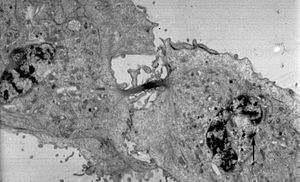Cytokinesis facts for kids
Cytokinesis is a super important step that happens after a cell has finished dividing its genetic material. Imagine a cell as a tiny house. After the "furniture" (the cell's DNA) has been perfectly copied and moved to two different sides of the house, cytokinesis is like building a new wall right down the middle. This splits the original house into two brand-new, identical houses!

What is Cytokinesis?
During cytokinesis, the cytoplasm (which is the jelly-like liquid inside the cell that holds all the tiny parts called organelles) splits into two equal halves. This creates two new cells, called daughter cells.
This amazing process starts right after the beginning of a stage called anaphase. It then continues through another stage called telophase. By the end of telophase, the cell has completely divided. After cytokinesis, if the cell divided using mitosis or meiosis II, it goes back into a resting and growing phase called interphase. Each of the two new cells now has its own complete and brand-new nucleus.
How Plant Cells Divide
Cytokinesis is a little different in plant cells compared to animal cells. Plant cells have a strong outer layer called a cell wall, which means they can't just pinch in and separate like animal cells do.
Instead, a special structure called a cell plate starts to form in the middle of the cell during late anaphase and throughout telophase. As the cytoplasm and organelles are shared equally between the two new cells, this cell plate gets stronger. It soon becomes a brand-new cell wall, completely separating the two daughter cells. So, in plants, cytokinesis builds a new cell wall, while in animal cells, it pinches the cytoplasm in half. The new cell wall then grows bigger as the two new cells expand.
Images for kids
See also
 In Spanish: Citocinesis para niños
In Spanish: Citocinesis para niños


